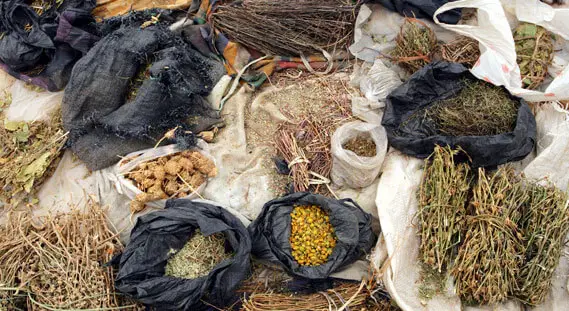Back in the days, our grandparents and their parents before them used traditional herbs for pain relief and treatment.
There were no modern hospitals, no modern medicine, and even when they came to be, treatment was not affordable to everyone.
I remember a story my grandmother gave me, of how the completely weak would be thrown out in the bushes to be devoured by wild animals off the little life they had left.
But many survived, and that’s because they discovered medicinal plants within their fields that came in handy.
And truth be told, these plants really worked, and the little to no side effects of these treatment options left them strong, with long lives ahead of them.
Time has passed, and now we all rush to pharmacies to acquire medicine and supplements.
However, these plants are still there, and can come in handy when used for the right purpose.
What are some of the medicinal plants that they used?
Most Popular Kikuyu Medicinal Plants
1. Mũkindũri (Croton Megalocarpus)
While some grow it as a plant and others use it for fencing the compound, this plant helps ‘glue up’ external wounds and cuts, and instantly stops the bleeding.
Just pluck from the tip of a young twig (this is the part that has the highest sap amount) and apply it to a fresh wound.
Herbalists have used the dried tree barks to make cough, malaria, pneumonia, and abdominal pain medication.
2. Mũtũndũ (Croton Sylvaticus)
The thick liquid extract from the tree is used to treat wounds, cuts, and bleeding gum.
3. Kĩongoro/mwongoro (Banana Tree)
Banana flower, also known as banana blossom, or kĩongoro/mwongoro (kikuyu), is a maroon/purple colored teardrop shaped flower that was a real magic for women in the kikuyu traditional community.
The banana blossom was used as a water container lid, squeezed in tightly, so that the juice from it would mix with water in the container.
Drinking that water offers relief from menstruation cramps, regulates menstrual flow, increase lactation in new mothers, and strengthen the uterus. It can also be cooked as a vegetable.
The banana flower can also be used to reduce high blood pressure, cure ulcers, anemia, and relieve constipation.
4. Mwĩnũ (Senna Didymobotrya)
It is mainly used to treat intestinal worms, ringworms, typhoid and malaria, and relieve constipation.
5. Wanjirũ wa rũriĩ (Ajuga Remota)
Traditionally, it was used in the community mainly to treat malaria.
However, in the past few years, during the pandemic, this plant has been believed to play a huge part in curing the effects of the corona virus.
6. Thafai or Hatha (Stinging Nettle)
This plant is widely used by healers to treat a wide range of sicknesses. It can be cooked as vegetables, added to mashed food, boiled, or dried and crushed.
It has been used as a detox, or cleanser to purify blood. It acts as a natural diuretic, which reduces water in the body that cause kidney and liver diseases.
It is good for people with high blood pressure and low blood count. It is also used to treat arthritis, gout, joint and muscle pain.
7. Mũkarakinga (Rhamnus Prinoides)
This plant is mainly added in bone soup, and is used as a blood purifier and to treat arthritis.
It is also used to treat intestinal worms, flu, pneumonia, and stomach ache.
8. Kĩĩruma (Aloe Lateritia)
This plant has been often confused with aloe vera since they have a few uses in common. Though not proven, many in the Kikuyu community have used it as hair mask to treat hair loss.
Traditionally, it has been used to treat severe heartburns, indigestion and stomach ache.
9. Mũgwanũgũ (Aloe vera)
This is a plant that has been widely used in modern medicine and remedies.
Locally known as mũgwanũgũ (kikuyu), it has been very useful to both humans and livestock.
Our grandparents used it to treat chicken disease by adding it in their drinking water.
Its most common use is in wound dressing, due to its wound-healing and anti-inflammatory properties.
It is also used to improve blood circulation, liver and kidneys functions, and treat chest problems, sore throat, and cough.
Aloe vera is also very useful in providing a smooth and spotless tone for people with acne, as it heals the pimples without leaving black heads.
10. Mũiri (Prunus Africana)
As a herb, its leaves are mainly used to improve appetite and treat genital infections.
Herbalists use its barks to relieve chest pains, treat kidney disease, malaria, stomach upset, fever.
It can also be used by patients with prostate enlargement.
11. Mũtamaiyũ (Olea Europaea)
This herb’s leaves are used to relieve a toothache, treat mouth infections and gonorrhea. They are also used to purify blood.
Its roots and barks are used to treat malaria.
12. Mũceege (Bidens Pilosa or blackjack)
Also referred to as beggar’s tick, this weed has been used to treat a wide variety of ailments.
The leaves are used to treat intestinal worms, constipation, stomach upset, bloating, and diarrhea.
Juice from the leaves is used in wound dressing and to treat ulcers.
Leaves sap is used as an eyedrop to relieve itching, to treat burns, skin itch and sores.
Roots are used to relieve toothaches, constipation, and tret malaria as well.
Closing Thoughts
Traditional medication is cheap, easy to come by, and in most cases, has no side effects.
It’s no wonder that even with modern medicine, some people still opt for these traditional herbs.



